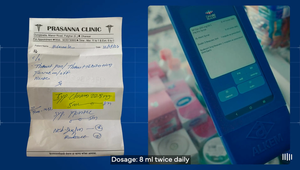
The Colour of Sound: Why Nippon Is Using Radio to Paint a Picture

Paint colours are typically expressed visually; after all, paint is a visual product. But Nippon Paint’s latest campaign presents colour through the auditory platform of radio, appealing to consumers’ ears instead.
“10,000 Colours” utilises sound and cultural nuances to showcase paint colours by tapping into local linguistics, and cultural associations between animals and colours.
Speaking to LBB’s Tom Loudon, Bellamia Agustina, growth director at MullenLowe Lintas Indonesia, breaks down how the campaign is helping the brand to stand out in today’s digital-first and visually saturated era.
LBB> What inspired the decision to present paint colours through the audio platform of radio rather than visually?
Bellamia> The “10,000 colours campaign” was exclusively launched in a radio format in Indonesia, stemming from a shared interest with the client to explore a unique format and a different way of showcasing their product.
The campaign aimed to showcase the rich array of paint colour choices offered by Nippon Paint, assisting consumers to articulate their preferred paint colours effortlessly. Recognising the challenge consumers face in expressing their desires for specific hues, we tapped into cultural association — where in Indonesia, certain colours are linked to animals. In Indonesia, many colours are associated with or named after animals, like the Red Jago, ‘Jago’ referring to a local chicken breed or the Green Frog.
LBB> How do you believe this unconventional approach resonates with consumers in today's digital-first and visually saturated era?
Bellamia> The choice of radio and the use of association between animals and colours is a way of tapping into local linguistics and understandings in a very subtle way. When people are already inundated with visual stimuli daily, we think this campaign is a simple but surprising way for people to hear about the brand (literally) that could serve as a more subtle reminder.
LBB> Can you explain how the campaign links paint colours with animals in Indonesian culture?
Bellamia> The radio spots featured the “voices” of animals, such as the frog or the chicken, naming colours while making their signature sounds. Making an auditory link between the various animals and the colours they represent can help Indonesian consumers to make a subtle, aural connection, which seeks to remind our audiences of these colours and creatively engage them so Nippon will remain top-of-mind.
LBB> What role does understanding local language and cultural nuance play in the effectiveness of this campaign?
Bellamia> Understanding local language and cultural nuances is absolutely integral to the success of our recent radio campaign, which focuses on simplifying the process of expressing colour preferences for consumers. From our observations, we've recognised a distinctive cultural tendency among Indonesians to associate specific colours with familiar elements, a practice ingrained in us since childhood. This includes a playful association with animals, such as Red Jago, Green Frog, and Grey Monkey, as well as other creative references like Pink Piggy and Black Crow.
What sets this cultural nuance apart is its extension beyond animals to encompass plants, foods, and nature, with descriptions like Pink Rose, Blue Sea, Blue Sky, Blue Salted Egg, and Green Kelepon. This whimsical and unique approach to describing colours is not only amusing but deeply resonates with Indonesians. Given this cultural richness in daily lives, we saw an opportunity to leverage these familiar references in our campaign.
We aim to make the campaign more than just an advertisement; we want it to be a shared cultural experience. By tapping into the local language and cultural nuances that we've grown up with, we believe the campaign becomes more relatable and relevant to our audience. This approach not only simplifies the communication of paint colours but also fosters a strong connection with consumers, turning the campaign into a celebration of the charming and distinctive ways Indonesians describe colours. Ultimately, it's about creating an advertising narrative that feels like a natural and authentic extension of our cultural identity.
LBB> What challenges did you encounter when implementing this creative approach, and how did you overcome them?
Bellamia> The most challenging part is creating authentic animal sounds and ambience using human voices. We extensively searched for voiceover (VO) talent, employing a rigorous selection process. Eventually, we discovered a skilled storyteller proficient in delivering impressive and lifelike animal voices.
LBB> How do you measure the success of a campaign that focuses on audio presentation in a predominantly visual industry? Has this campaign been successful?
Bellamia> As the campaign exclusively aired on radio, gauging its success or assessing audience response is challenging. We know from client feedback that customers use animal voices when discussing colours in stores, so we understand that the audience is listening and absorbing the message from Nippon. The client is really happy with this.
LBB> Are there plans to expand this audio-based approach to marketing paint colours to other regions or markets?
Bellamia> Not as of now. Typically, clients encounter various issues or challenges that require different approaches, leading to the development of campaigns that vary based on the current circumstances. We will develop campaigns based on those specific needs, including the “10,000 colours” campaign.















